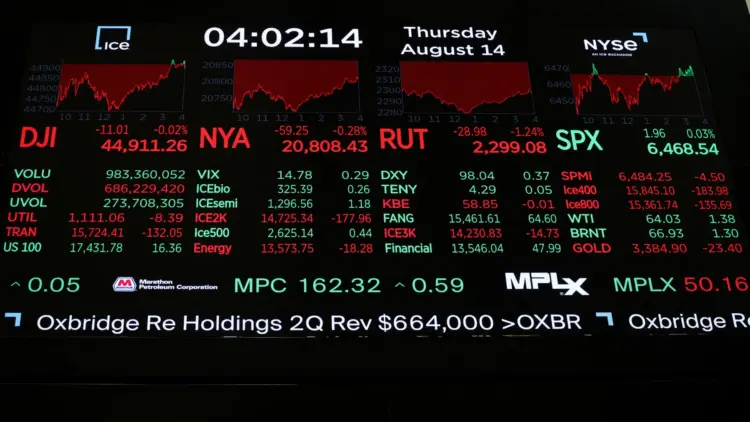Wall Street’s dramatic retreat from record highs signals a pivotal shift in market sentiment as unexpectedly hot producer price inflation shattered investor confidence in aggressive Federal Reserve rate cuts. The shocking 0.9% monthly surge in wholesale prices—the largest increase in three years—has forced traders to recalibrate their expectations for monetary policy easing just weeks before the Fed’s crucial September meeting.
Market reaction and Fed expectations after an inflation surprise
This inflation surprise threatens to derail the market rally that had propelled major indices to new peaks, highlighting the delicate balance between economic growth and price stability that continues to challenge policymakers. The market’s swift reaction underscores how sensitive investors remain to inflation data that could influence the Fed’s policy trajectory and reshape the investment landscape for months ahead.
Wall Street’s main indexes eased on Thursday, after a hotter-than-expected producer prices report dampened investor expectations of potential interest-rate cuts by the Federal Reserve this year.
A Labor Department report showed producer prices increased the most in three years in July due to a surge in the costs of goods and services, suggesting a broad pickup in inflation was imminent.
Traders trimmed their Fed rate-cut expectations for the rest of the year to about 56.7 basis points, according to data compiled by LSEG, compared with around 63 bps before the report.
But they are still fully pricing in a quarter-percentage-point cut in September.
Policy implications of American trade policies
“The implication is that the Fed is going to offer a 25-(basis point) cut in September. But it will be a hawkish cut. It’s way too early still for the Fed to wish to guide the market towards an extended easing cycle,” said Thierry Wizman, global FX and rates strategist at Macquarie Group.
“The next important thing will be the Expenditures Price Index later this month. If there are signals that there’s inflation broadly in services, the market will take that adversely.”
A separate report on Thursday showed the number of Americans filing new applications for jobless benefits fell last week.
At 02:04 p.m. ET, the Dow Jones Industrial Average .DJI fell 98.37 points, or 0.22%, to 44,823.90, the S&P 500 .SPX lost 3.70 points, or 0.05%, to 6,463.05 and the Nasdaq Composite .IXIC lost 3.04 points, or 0.01% to 21,710.10.
Market valuation concerns arise due to tariff adjustments
Recent data reflecting labor market weakness and a moderate rise in consumer prices had strengthened expectations that the central bank will potentially lower interest rates next month.
However, Thursday’s report fanned concerns that U.S. tariffs on imports could start to impact prices in the coming months and dampen a rally in U.S. stocks that had helped the benchmark S&P 500 .SPX and tech-heavy Nasdaq.IXIC log record highs over the past two sessions.
The corporate impact of increased U.S. tariffs on imports
On Thursday, seven of the 11 S&P 500 sectors declined, with materials .SPLRC is falling the most, down 1.1%. Cisco Systems CSCO.O lost 1.6% after the network equipment manufacturer’s broadly in-line forecast did little to encourage investors.
Deere & Co DE.N fell 6.85% after the farm-equipment maker reported a lower quarterly profit and tightened its annual profit forecast, while Tapestry TPR.N pl,unged 14% after the Coach handbag maker forecast annual profit below estimates.
Both companies warned of tariffs impacting their businesses.
The hot producer price inflation data has fundamentally altered the market narrative from confident rate-cut expectations to uncertainty about the Fed’s policy path, creating a more challenging environment for risk assets. Corporate America’s growing warnings about tariff impacts combined with elevated market valuations suggest investors face a perfect storm of policy uncertainty and economic headwinds.
The Fed’s September meeting has become a critical inflection point that will determine whether markets can sustain their record-high levels or face a more significant correction. This inflation shock serves as a stark reminder that the path to monetary policy normalization remains fraught with unexpected challenges that could reshape investment strategies.
GCN.com/Reuters.


